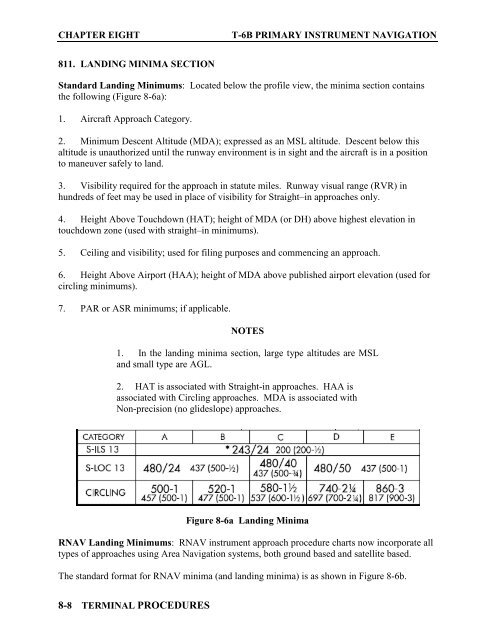Flight Training Instruction - Cnatra - U.S. Navy
Flight Training Instruction - Cnatra - U.S. Navy
Flight Training Instruction - Cnatra - U.S. Navy
You also want an ePaper? Increase the reach of your titles
YUMPU automatically turns print PDFs into web optimized ePapers that Google loves.
CHAPTER EIGHT T-6B PRIMARY INSTRUMENT NAVIGATION<br />
811. LANDING MINIMA SECTION<br />
Standard Landing Minimums: Located below the profile view, the minima section contains<br />
the following (Figure 8-6a):<br />
1. Aircraft Approach Category.<br />
2. Minimum Descent Altitude (MDA); expressed as an MSL altitude. Descent below this<br />
altitude is unauthorized until the runway environment is in sight and the aircraft is in a position<br />
to maneuver safely to land.<br />
3. Visibility required for the approach in statute miles. Runway visual range (RVR) in<br />
hundreds of feet may be used in place of visibility for Straight–in approaches only.<br />
4. Height Above Touchdown (HAT); height of MDA (or DH) above highest elevation in<br />
touchdown zone (used with straight–in minimums).<br />
5. Ceiling and visibility; used for filing purposes and commencing an approach.<br />
6. Height Above Airport (HAA); height of MDA above published airport elevation (used for<br />
circling minimums).<br />
7. PAR or ASR minimums; if applicable.<br />
8-8 TERMINAL PROCEDURES<br />
NOTES<br />
1. In the landing minima section, large type altitudes are MSL<br />
and small type are AGL.<br />
2. HAT is associated with Straight-in approaches. HAA is<br />
associated with Circling approaches. MDA is associated with<br />
Non-precision (no glideslope) approaches.<br />
Figure 8-6a Landing Minima<br />
RNAV Landing Minimums: RNAV instrument approach procedure charts now incorporate all<br />
types of approaches using Area Navigation systems, both ground based and satellite based.<br />
The standard format for RNAV minima (and landing minima) is as shown in Figure 8-6b.
















